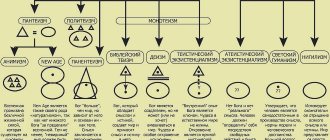Updated September 28: 99,989 Author: Dmitry Petrov
Hello, dear readers of the KtoNaNovenkogo.ru blog. In modern political science, it is customary to distinguish three political regimes: totalitarianism (what is it?), democracy (what is it like?) and authoritarianism.
The latter belongs to the category of non-democratic, characterized by a strong-arm management style and a limited number of citizens’ freedoms.
Society has an ambiguous attitude towards this regime - some criticize it for the presence of many restrictions, others praise it for the order.
Let's take a closer look at its signs and characteristics in order to draw our own conclusions about authoritarianism.
What is AUTHORITARISM - definition, meaning in simple words.
In simple words, Authoritarianism (Authoritarian regime) is a theory and system of government, usually associated with dictatorship, as opposed to democracy, that arose in response to state crises of the political system (democratic failure, social polarization, economic stagnation and international instability).
For almost all of human existence, authoritarian forms of government have existed. An authoritarian regime exercises sovereign power through one-party rule and may depend on the military to maintain order. In its extreme control over society, it can become a totalitarian monopoly.
It is a principle based on submission to authority and is opposed to people's autonomy in thought and action. As a form of government, authoritarianism concentrates power in the hands of
- leader (cult of personality)
or
- a small elite (elite dictatorship), which is constitutionally not accountable to the people.
Unlike totalitarian systems, authoritarian governments usually lack a highly developed ideology. Leaders of authoritarian systems often exercise their power arbitrarily and consider themselves above the existing law. Modern authoritarian systems typically operate through single dominant parties that control the government and other key parts of society, including the economy, the media, and education. They usually do not hold free elections that could replace them with a rival party. It is difficult or impossible for citizens to form opposition groups or parties.
Authoritarianism is...
An authoritarian regime (Latin Fuctoritas “influence, power”) is one of the types of political regimes in which the highest state power is concentrated within one ruler or a narrow group of the political elite. Often combined with autocracy, dictatorship of the individual and oligarchy.
In general terms, it is considered as a rule that is rigid in style , the basis of which is forceful methods used to regulate social processes.
This creates conditions for a sharp increase in the role of the security apparatus - the armed forces, police, intelligence, prosecutor's office (what kind of structure is this?).
As a result, many democratic institutions are completely excluded or are of an openly formal nature.
Authoritarianism does not require citizens to demonstrate maximum devotion, but at the same time excludes any unveiled opposition to power.
Authoritarianism and democracy.
The term "authoritarian regimes" in its broadest sense covers all forms of non-democratic government. Compared to democracies, authoritarian regimes do not support
- institutions and participation procedures,
- political competition,
- fundamental rights and control of power (separation of powers, parliaments, elections, plurality of parties, etc.) characteristic of democracy, and thus lacks democratic legitimacy.
Signs of an authoritarian regime
In political science, the following signs of authoritarianism are identified:
- pronounced centralization of management;
- restriction of the political rights of the population (freedom of the media, the existence of the opposition, some forms of political participation and even voting rights);
- active use of force by political authorities, reliance on intelligence, the army and other organs of the security apparatus;
- the nominal existence of individual rights and freedoms enshrined in the Basic Law of the country;
- the system of separation of powers does not work fully, for example, the courts are controlled by the state, and parliament (what is this?) is deprived of independence.
The authoritarian style of government is not controlled by citizens, who cannot change the regime through elections. It involves selective use of laws at the discretion of management.
Recruitment of the political elite is carried out by the method of co-optation, which involves the independent selection of new personnel by the ruling circles.
In foreign policy , signs of aggression often appear; there is a desire to invade the sphere of interests of other states and even occupy their territory.
Signs of authoritarianism.
Juan Linz, whose 1964 description of authoritarianism is influential, characterized authoritarian regimes as political systems by the following qualities:
- “limited rather than responsible political pluralism” in contrast to the fundamentally unlimited pluralism of democracies; that is, restrictions on political institutions and groups (such as legislatures, political parties and interest groups),
- lack of “intensive or extensive political mobilization” and restrictions on the mass public (for example, repressive tactics against opponents and prohibition of anti-regime activities),
- "formally vague" executive power, often changeable or vague.
The difference between authoritarianism and totalitarianism
| Authoritarianism | Totalitarianism |
| The authorities are only interested in political life and the defense of the country. | The government controls not only politics, but also the economy, public and private life. |
| The authorities do not exercise special control over the political worldview of citizens. The authorities simply deprive them of political rights and, consequently, the opportunity to participate in the life of the state. | Always is political ideology. This is an attempt by power to influence what and how people think. Under totalitarianism, there is propaganda of some political idea. In the USSR this idea was communism, in Germany under Hitler it was Nazism. |
| The authorities may not have a particular opinion about the dominant nation or race in the country. The emphasis is on politics . | People or entire nations may be declared objectionable. They are persecuted and subjected to political repression. That is, punishment carried out on the orders of the leader of the country. |
| The personality cult of the state leader does not play a special role. The leader may not have outstanding charisma. He is not glorified or exalted. |
Read more about the Totalitarian regime.
Types of authoritarian rule.
Linz identifies seven types of authoritarian rule:
- Bureaucratic-military management.
- Authoritarian corporatism.
- Mobilizing authoritarian regime.
- Post-colonial authoritarian regime.
- Racial and ethnic "democracies".
- Incomplete totalitarian and pre-totalitarian regime.
- Post-totalitarian authoritarian regime.
Types of authoritarian governments also include:
- absolute monarchy
- military dictatorship
- ideological regimes.
Forms of authoritarian management.
Typically, authoritarian governance takes the following forms:
Authoritarian monarchy
The most traditional political system in the modern world is an authoritarian monarchy. The basis of its legitimacy is common and often associated with mythical assumptions regarding the founding of the dynasty in question. Examples of this type are Ethiopia (before 1974) and Saudi Arabia. Accession to the throne is usually governed by heredity, and there is little or no open political competition. There is no formal separation of powers, and power structures are personalistic and reinforced by the aristocratic ideology of the upper class. In earlier times, most such regimes were built on feudal agrarian structures. Today they tend to have centralized and absolutist characteristics.
"Old" oligarchy
This type of authoritarianism is prevalent in Latin America. This is a traditional authoritarian regime. Such a regime receives support from feudal or "neo-feudal" rural structures and, since the late twentieth century, from sections of the urban upper class. In extreme forms of the old oligarchy (such as Nicaragua before 1979), a small number of leading families exercise almost exclusive control over the political and economic life of the country. In this system, one leader can be replaced relatively easily by another, sometimes through rigged elections that do not fundamentally change the power structure. Political activities and the media are usually controlled by the regime's repressive apparatus. Other elements that make up the separation of powers, such as an independent judiciary or a federal structure, are also missing.
"New" oligarchy
The "new" oligarchy receives support from dominant urban groups in the modern context. In this “hegemonic” regime, there is no open competition for government positions. Usually there is a one-party structure, which, however, is predominantly formal and ineffective. Instead, much emphasis is placed on bureaucracy. Public opinion and the media are controlled, and leadership is centralized and highly personalized. There may be some charismatic elements of legitimacy in this regard. Compliance is established either by passive acceptance or by repressive measures. Both social base and “inclusiveness” vary along ethnic and class lines. In most cases, a relatively broad ethnic base is combined with more limited class interests that favor the advantaged groups of society. Examples include countries such as Cameroon, Tunisia and the Philippines (under Ferdinand Marcos; 1917–1989).
Semi-competitive authoritarianism
In Latin America, this system was also based on traditionally dominant classes, but there is a greater balance between rural and urban elements. Opposing elements are often institutionalized in "conservative" and "liberal" parties, for example in nineteenth-century Chile, Colombia or Uruguay. Active participation remains limited to the middle and upper strata of the population. Semi-competitive regimes tend to follow established constitutional rules within a presidential or parliamentary system. Regular transfers of power occur within established limits. As a rule, they are less repressive than “oligarchic” systems. The media also often enjoy greater freedom.
Socialist authoritarianism
“Socialist” regimes reveal a different pattern. They are characterized by an effective one-party organization, a centralized system of government, and an ideology aimed at social order and “non-capitalist” and “self-reliant” development. Freedom of expression and pluralistic forms of organization are restricted. However, there are many variations. One group (such as post-independence Tanzania and Guinea) attempted to base their specific type of socialism on the traditions and culture of their societies. Another group (e.g. Algeria, Mozambique) championed a Marxist-oriented “scientific” brand of socialism. In both groups there may be some semi-competitive elements in the internal party and parliamentary spheres. Socialist regimes should be distinguished from their totalitarian "communist" counterparts, if only because of their overall "underdevelopment" and relative lack of effective social control.
Military regimes
In addition to civilian regimes, there are systems that are controlled by military rulers who came to power through a coup d'état after previous civilian institutions failed. In the absence of significant countervailing forces, the military's monopoly on physical coercion makes less effective civilian governments easy prey for armed groups. The social foundations of these regimes are usually quite narrow. Some military rulers act as temporary caretakers and make sincere attempts to return their countries to civilian rule (like Olusegun Obasanjo in Nigeria in 1980). Others, on the contrary, seek to establish their power forever.
Three subtypes of military authoritarian regimes can be distinguished:
- personal military authoritarianism (centered around the “strong man” and his closest followers);
- corporate military authoritarianism (there is a certain institutionalized transfer of power established within the leadership ranks of the armed forces);
- military socialist authoritarianism (establishes its power on a permanent basis by creating a one-party system).
Authoritarian political regime
Bibliography
The essence and distinctive features of political authoritarianism. Types of authoritarian regimes
An authoritarian regime is a political regime in which state power is exercised by one person or a narrow circle of people (the ruling elite) with minimal participation of the population.
An authoritarian regime is a regime that limits democracy and establishes the power of one person or group of persons (dictatorship). Such a regime significantly limits the powers of representative institutions, ignores the principle of separation of powers, infringes on civil and political rights, and illegally appropriates or seizes power.
In its most general form, authoritarianism has the appearance of a system of strict political rule, constantly using coercive and forceful methods to regulate basic social processes. Because of this, the most important political institutions in society are the disciplinary structures of the state: its law enforcement agencies (army, police, intelligence services). With this style of government, the opposition is excluded not only from the sphere of decision-making, but also from political life in general. Elections or other procedures aimed at identifying public opinion and citizens’ requests are either absent or used purely formally.
Autocracy (autocracy, autocracy, i.e. unlimited power of one person) does not require a demonstration of loyalty on the part of the population, as with totalitarianism; the absence of open political confrontation is enough for it. However, the regime is merciless to manifestations of real political competition for power, to the actual participation of the population in decision-making on the most important issues in the life of society. Authoritarianism suppresses basic civil rights.
The signs of an authoritarian political regime are:[1]
- in the center and locally there is a concentration of power in the hands of one or several closely interconnected bodies while simultaneously alienating the people from the real levers of state power;
- the principle of separation of powers into legislative, executive and judicial is ignored (often the president and executive-administrative bodies subordinate all other bodies to themselves and are endowed with legislative and judicial powers);
- the role of representative government bodies is limited, although they may exist;
- the court acts, in essence, as an auxiliary body, along with which extra-judicial bodies can be used;
- the scope of the principles of election of government bodies and officials, accountability and controllability of their population has been narrowed or nullified;
- command and administrative methods dominate as methods of government, while at the same time there is no terror, mass repressions and harsh violent methods of exercising political power are practically not used;
- partial censorship remains, there is a kind of “semi-publicity”;
- the official ideology dominates in society, but tolerance is shown towards other ideological movements that are loyal to the ruling regime;
- the rights and freedoms of citizens are limited mainly in the political sphere. The laws are predominantly on the side of the state, not the individual;
- politics is monopolized by power. The activities of political parties and opposition are prohibited or limited. Trade unions are controlled by the authorities.
At the same time, the absence of any sign does not remove the stigma of authoritarianism from the regime, just as one cannot judge the authoritarian nature of the regime by one sign. For this reason, the issue of the political regime in the country is often controversial.
The most undesirable form of manifestation of authoritarianism is a totalitarian regime. The main characteristics of a totalitarian regime are: state control over all areas of public life (unjustified interference in the economy), complete subordination of a person to political power and the dominant ideology, militarization, establishment of totalitarian “legality”, etc.
Hence the main difference between an authoritarian regime and a totalitarian one: an authoritarian regime extends its principles only to the sphere of the state apparatus (officials, army and police) and in parallel with this, civil society continues to exist, which this state apparatus controls. You can also see a significant difference between them in the nature of power relations with society and the individual. If under authoritarianism these relations are differentiated and based on “limited pluralism,” then totalitarianism generally rejects pluralism and the diversity of social interests. Moreover, totalitarianism seeks to eliminate not only social, but also ideological pluralism and dissent.
Totalitarianism is the dictatorship of the state, and authoritarianism is the dictatorship of the individual or group. In authoritarianism, the role of the leader is high, but unlike totalitarianism, the leader, as a rule, is not charismatic.
Compared to totalitarian rule, authoritarianism is not free to exercise its power. Society preserves institutions that pose a real threat to the regime: family, clan, church, social class, urban and rural culture, social movements and associations. In other words, society retains a fairly powerful potential for the formation and activities of opposition political groups.
In addition, unlike totalitarianism, an authoritarian regime does not pretend to subjugate a person’s spiritual world or control his consciousness. Authoritarianism, as a rule, allows for a certain autonomy in a person’s personal life.
From modern typologies of authoritarian regimes, the following main types of authoritarianism are distinguished:
- Military dictatorships that rely on the army. In conditions of an undeveloped civil society and weak democratic traditions, the military is the most organized force with the resources to seize power (usually through a coup d'etat).
- Theocratic - based on the clergy and religion.
- Oligarchic - power belongs to certain corporate clans.
- Leader (personal power regime), based on the authority of a strong leader. The regime itself may have the support of the people. The basis for the emergence of such regimes may be the feeling of an external threat to the country. The leaders themselves often use nationalist slogans, ideas of independence or a “modernization breakthrough” (a quick solution to the problems of economic backwardness and poverty) to consolidate the population around their own power.
- Mixed, combining elements of different modes.
An authoritarian regime can exist in different forms.
But with any form of authoritarianism, state power is not really formed and controlled by the people. Despite the fact that representative bodies may exist, they really do not play any role in the life of society. Parliament stamps decisions developed by the ruling elite led by a leader or group of people (junta, oligarchy).
Often, authoritarian regimes in a relatively “soft” form are implemented to carry out reforms, strengthen the state, its integrity, unity, and oppose separatism and economic collapse. In an authoritarian state, management is usually carried out centrally.
Strengths and weaknesses of authoritarianism. Reform possibilities of modern authoritarian regimes.
The impact of authoritarianism on social development has both weak and strong sides.
One of the weaknesses is the complete dependence of politics on the position of the head of state or a group of senior leaders. Several parties can participate in political life, but all these parties must follow the line developed by the ruling party, otherwise they are banned and dispersed.
An authoritarian regime is merciless to manifestations of real political competition for power, to the actual participation of the population in decision-making on the most important issues in the life of society, therefore authoritarianism suppresses basic civil rights.
In addition, the decisions of the central government, which often do not take into account the economic, national, geographical, everyday, religious and other characteristics of certain groups of the population, are not carried out voluntarily. If people deviate from the “general line,” coercion is used. A person in an authoritarian state cannot actually enjoy freedoms, even if they are formally proclaimed, since there is no mechanism for their implementation and the guarantees are fictitious. Society is also deprived of guarantees of its security in its relations with the authorities, since the authorities do not hesitate to use coercion.
Hence the lack of opportunities for citizens to prevent political adventures or arbitrariness, the limited institutions of articulation and political expression of public interests.
Due to the persistent disregard for public opinion, the formation of state policy without the involvement of the public, in most cases makes the authoritarian government unable to create any serious incentives for the social initiative of the population.
Authoritarian regimes should not be seen as instruments for the expression of minority interests. Modern authoritarian regimes use a fairly wide range of resources, and not just means of coercion and political repression. Their peculiarity is a noticeable reduction in the proportion of methods of indoctrination and political coercion.
Authoritarianism more often uses economic incentives: creating opportunities for increased prosperity for broad sections of society, pursuing effective social policies. The practical effectiveness of a number of authoritarian regimes (for example, in South Korea, Singapore, Taiwan) allowed them not only to solve the problems of technological modernization and significantly improve the standard of living of the population, but also to attract large sections of society to their side.
This gives rise to the strengths of authoritarianism , which are especially noticeable in extreme situations. Authoritarian power has a relatively high ability to ensure political stability and social order, mobilize public resources to solve certain problems, and overcome the resistance of political opponents. All this makes it a fairly effective means of carrying out radical social reforms.
In this regard, it can be noted that authoritarian regimes have significant mobilization and orientation capabilities due to the ability to concentrate resources on strategic areas of development.
But, in comparing the effectiveness of socio-economic reforms by an authoritarian regime or a democratic one, it seems to me that it is also worth taking into account the main features of both regimes.
Any authoritarianism is internally contradictory, difficult to predict and potentially unstable. As a rule, the conditions that allow him to stay in power are not so much political as social and economic. Politically, authoritarianism most often has neither a stable source of power nor reliable support in the form of a mass movement. Moreover, authoritarianism often takes root and exists in a segmented society, in which none of the competing political groups has a chance to seriously undermine the chances of the ruling elite.
However, it cannot be said unequivocally that a democratic regime is better and that it is simpler and easier to carry out social and economic reforms, because democracy tends to stabilize only in relatively favorable socio-economic conditions, stable growth of gross domestic product and income of the population. Democracy has its own contradictions, which are inherent in the very nature of public power - the real inequality of people and their abilities, the advantages of the status of government institutions over the status of individuals, etc.
Called to embody the priority of public interests over private ones, democratic power is at the same time filled with the activity of numerous groups, often acting in the exact opposite direction and subordinating its (power) mechanisms to their own plans and needs. Thus, democracy, while achieving balance in political relations, is fraught with a double danger: it can either become an exclusive form of preference for private, corporate interests (elites, bureaucracy, certain groups of citizens) over public ones, or slide into forms of government that consign any private interests.
The positive experience of transforming a number of backward countries, which managed to quickly and relatively painlessly transform into prosperous, open and stable societies, confirms the effectiveness of using authoritarian methods to carry out a number of reforms. We are talking about the prosperous and fast-growing economies of East Asia (Taiwan, South Korea, Singapore), the Persian Gulf (Saudi Arabia, Oman, Qatar, Bahrain, Kuwait, UAE) and South America (Chile); This also includes the development of countries such as China, Uganda, Thailand, Malaysia, etc.
The authoritarian regimes of these countries were able, to one degree or another, to transform into democracies faster, more successfully and, by all indications, more irreversibly than democratically oriented developing or post-communist countries.
These countries demonstrate a transition to democracy through authoritarianism and the institutionalization of authoritarian forms of democracy. Embarking on the path of market-oriented modernization, these countries first strengthened political control (since a characteristic feature of the economic policy of authoritarian regimes is its focus on budget expenditure items, in which the possibility of theft of funds and corruption on the part of political elites is greatest), which, ultimately led to the creation of basic elements of democracy, for example, middle-income strata, openness to the outside world, integration into the world economy. In other words, these political regimes first established dictatorial systems and then (or simultaneously) pursued an aggressive policy of government intervention in the market economy while simultaneously stimulating the latter.
To date, there are examples of “bad” democracies that led to disaster (Weimar Germany, post-colonial India, Gorbachev’s USSR, attempts at democratization in Nigeria, Sudan, etc.), and “good” authoritarianisms (Singapore, Taiwan, South Korea, Uganda, Indonesia ), leading to democracy (to varying degrees).[2]
Taking into account the above, I can conclude that neither of the two political regimes can be clearly called the only correct one in the field of reforms. It is also necessary to take into account the historical background of a particular country and how development took place. Blindly applying one or another mode may not always lead to success. It seems to me that the most suitable political regime can be called authoritarian-democratic. Because for successful development it is necessary to combine the main advantages of the two modes.
It is necessary to have a decisive role of the state that regulates economic development, the creation of an optimistic ideology of reforms that take into account common values and stereotypes when people trust the decision of the state, and the most important factor is the personality of a leader who embodies the idea of loyalty, integrity and decency.
The main function of authoritarian democracy is the creation of a middle class “from above” by the power regime. And we must remember that the main criteria for the successful existence and development of any state are:
- the economic growth;
- social benefits;
- political stability;
- positive international participation;
- legal protection.
The current Russian political regime is often described as transitional from authoritarianism to democracy. Indicate specific manifestations of the features of authoritarian and democratic regimes in the functioning of the modern Russian political system
It has become a commonplace for politicians and political scientists to say that modern Russia is in a transition period.
The modern Russian political system is determined by the Constitution. Despite the presence of provisions in it that give the right to characterize it as democratic, in reality the political system of Russia in many ways does not meet the generally accepted criteria of democracy, the most important of which are the representativeness of power, its responsibility to society, and the presence of effective public control over power. The redistribution of powers is clearly biased towards the executive branch, and especially the president. The real leverage of other branches of government to influence his policies is seriously limited.[3]
Within the Russian political system, both democratic and non-democratic methods of exercising power coexist, which allows us to talk about the duality of the modern political regime.
A feature of Russia's modern development is the emergence of a regime for which the interests of the state and society do not coincide. This means that public power at this stage does not have an effective political structure. Political scientists call this regime hybrid or transitional. Although it has signs of democracy, it is not yet democratic.
On the one hand, a decisive step on the path to democracy is the transition to an electoral system of government formation. Free alternative elections retain the potential to transform Russian democracy from regime democracy to real democracy. Voters are the most important resource of the regime system. In today's Russia, no politician can build or win power without using votes as a resource. If the political potential of an authoritarian resource existed, it would undoubtedly be taken advantage of.
At the same time, modern political practice creates institutions that are formally democratic, but are not responsible to society. Thus, political parties mainly maintain connections with the elite and mobilize ideological and political resources for inter-elite struggle. The economy in Russia is developing according to market laws in the absence of an effectively functioning market system, so entrepreneurs seek to use existing laws to gain independence from the bureaucracy in order to protect their personal and property rights.
At the same time, the institutions of democracy (parliament, courts, local government) retain the ability to function independently and are the foundation of the transition to a democratic regime.
Among the main features of the authoritarian regime in the modern Russian political system, the following can be distinguished: a sharp weakening of the political influence of regional elites and big business; establishing direct or indirect state control over the country's main television channels; the constantly increasing use of “administrative resources” in elections at the regional and federal levels.
The following fact can be cited as a striking example of the manifestation of authoritarianism. Having received a constitutional majority in the State Duma, the United Russia political party, which has declared full support for the policies of the current president, has unlimited opportunities to implement political and economic reforms and change the political system of society, which was demonstrated at the end of 2004 by the adoption of a federal law , changing the procedure for electing heads of executive power of the constituent entities of the federation. Increasing the entry barrier for political parties from five to seven percent, all this can also hardly be called a democratic measure.
The desire of the current regime in Russia to manage political contacts with business, to dominate the party and media markets, to control civil structures, etc. indicates that he is trying to replace his own activity with the activity of all his political partners. As a result, the completely natural process of politicization of public administration is transformed into the process of policy management with the accompanying interception of representative functions from the population and business, neglect of the opinions of civil contractors and inhibition of political activity of society.
There is a known case when V.V. Putin demonstrated decisiveness in neutralizing the influence on the government of those oligarchs who financed and controlled the media that launched a PR campaign against the president. These events have raised concerns about the status of independent media in Russia.[4]
On the other hand, in modern Russia the characteristic features of democracy are becoming more and more clearly visible: the foundations of legal statehood are being built and the foundations of civil society are being created; power at the federal and local levels is elected and replaceable; mechanisms of direct democracy (referendums) operate, there is a system of separation of powers in the state; fundamental human rights are guaranteed, there is a real political opposition, including “irreconcilable” ones; Formally, the judiciary is independent of the executive authorities; there is no leading ideology; a free and competitive market is emerging in the economy with a variety of forms of ownership; There are independent media and communications.
Since 2006, the Public Chamber began to operate, one of the most important tasks of which is to conduct an examination of the most significant bills in order to realize the interests of society.
But it is worth remembering other important components in modern Russia. As a result of the ongoing reforms in the country, a huge gap has formed between the rich and the poor, which, in the absence of a stabilizing “middle class,” leads to the growth of authoritarian sentiments. According to government data, in 2004 the difference in income between the richest 10% and the poorest 10% of people in Russia was 14.1 times, in 2005 it was 14.8 times. Those. What is observed is not a reduction, but an increase in the gap, which becomes dangerous. In developed countries the gap is 4-7 times. The problem of democracy is not particularly relevant in a poor country where people think more about survival than about respecting human rights. People, accustomed to receiving everything they need from the state, do not know what to do with the freedom that right-wing parties promise them.
Freedom, not supported by the material component that the social state must provide, is a burden for a person. In order to live well in conditions of freedom, it is necessary to take initiative, improve your professional level, not rely on government help, but, if possible, solve life’s problems yourself. This requires psychological readiness of the individual, as well as assistance from the state, which, with the help of legal norms, must ensure the realization of citizen freedom in the political, economic, social, cultural and other spheres. Political institutions and bureaucracy must work accordingly, which in Russian conditions is the main obstacle to the establishment of democratic freedoms.
To strengthen democratic tendencies in Russia, it is necessary to carry out reforms that have a positive result for the majority of people: reforms of the administrative and state apparatus, creating conditions for the effective functioning of small and medium-sized businesses, pension reform, local government reform, health care and education reforms.
Taking into account all of the above, we can conclude that an authoritarian regime is now necessary for modern Russia, because it contributes to the creation of the necessary material and spiritual prerequisites for a future democratic regime.
Bibliography
- V. Chervonyuk, I. Kalinsky, G. Ivanets. Encyclopedic Dictionary “Constitutional Law of Russia”, 2002.
- Gutorov V.A. Modern Russian ideology as a system and political reality. Methodological aspects // Polis. 2001. No. 3.
- Printed materials of the international scientific and practical conference. - Omsk: Omsk State Pedagogical University Publishing House, 2001.
- Smolin O.N. Political process in modern Russia: textbook. allowance. M., 2006.
- Soloviev A.I. Political science: Political theory, political technologies:. Textbook for university students. – M.: Aspect Press, 2000.
- Theory of Politics / Ed. B.A. Isaeva. – St. Petersburg: Peter, 2007.
- Tsygankov A.P. Modern political regimes: structure, typology, dynamics. – M.: , 1996.
- Shestov N.I. The idea of the country’s unity and the reform of the Russian political system // Polis. 2004. No. 6.
- Yakovlev A.N. Reformation in Russia // Social sciences and modernity. 2005. No. 2. P.11.
- Internet source: www.gazeta.ru Official website, archive for 2004, No. 8, p. 5.
[1] V. Chervonyuk, I. Kalinsky, G. Ivanets. Encyclopedic Dictionary “Constitutional Law of Russia”, 2002.
[2] Printed materials of the international scientific and practical conference. - Omsk: Omsk State Pedagogical University Publishing House, 2001.
[3] Educational and methodological manual: Political relations and the political process in modern Russia: Plan and content of the course / Author's compilation. N.A. Baranov. St. Petersburg: Publishing house of BSTU. 2003.
[4] Internet source www.gazeta.ru, archive for 2004, No. 8, p. 5.
What is an authoritarian government?
An authoritarian government is a government that wields power and carries out policies without the consent of the people it rules.
It is not elected by the people and has absolute power to rule as it pleases without consulting the people it rules. This may be a government in which one person acts as an absolute ruler, or a government consisting of a specific group of people, such as a political party. Authoritarian governments are typically characterized by suppression of dissent and control of the flow of information. All media are subject to strict censorship. In many cases, the media is used as a tool of an authoritarian government to make it and its policies appear more popular in the eyes of the general population.
Authoritarian governments can come to power by force of arms, as the anointed successors of previous authoritarian regimes, or even through democratic means.
Specific properties of authoritarian power
Authoritarianism manifests itself in the following signs:
- Maintaining monopoly control of the state in the hands of the authorities. Power may be in the hands of an individual, a party or a social group;
- Lack of opposition to government. The authoritarian regime partially or completely limits the formation of political opposition;
- State power is centralized and rigid;
- The board is formed in a completely undemocratic way, i.e. there is no election system and power is inherited, through seizure, co-optation;
- The authorities rely on and actively use power structures in their governance. They suppress all popular indignation, protests,
- The government is not controlled by anything or anyone, the people have no means of protection from the government and cannot limit its activities;
- Command style of management. Repression is the priority way to combat opponents of the political regime;
- Anti-democratic orientation of actions;
- The absence of a constitution or its presence only on paper, without real reliance on it when passing laws and developing directions of state policy;
- The predominance of ideology enshrined at the state level;
- The political elite is not selected through popular vote, but through selection by the government representatives themselves, i.e. Appointment comes from the top rather than through competition;
- Lack of implementation of the principle of separation of powers. In fact, neither parliament nor the court has real power, but is completely subordinate to a single ruler or authority;
- The states and the ruling party are represented as one;
- It is possible for an authoritarian regime to rely on traditional social institutions - the church, the bureaucracy;
- The economic structure is characterized by diversity. With the predominance of the public sector and state control of all spheres of the social structure, a market economy or a mixed type economy may well be developed;
- Aggressive foreign policy. The authoritarian regime relies on and actively develops demagoguery, intensifies racial discrimination and national hostility;
- An ideology often develops that involves fanatical worship of state power. For this purpose, various intimidating events are carried out, and the philosophy of servility is promoted.
Finished works on a similar topic
Coursework Authoritarianism 430 ₽ Essay Authoritarianism 270 ₽ Test paper Authoritarianism 250 ₽
Receive completed work or specialist advice on your educational project Find out the cost
Authoritarianism and totalitarianism: differences.
Totalitarianism is authoritarianism, but it goes beyond it. In an authoritarian system, there are few social and economic institutions outside the control of the government.
- An authoritarian system wants full political power, but does not go beyond that.
- A totalitarian system of government wants power over everything and everyone.
Representatives of totalitarian regimes seek power outside of government and begin to invade the personal life and ideology of everyone under their power.
One of the most famous examples of a totalitarian ruler was Adolf Hitler. He went beyond political rule and sought control over what people believed and even what race he thought people should be. Another key difference is how they execute their decision. An authoritarian ruler is more focused on individual power, while a totalitarian ruler is more of a charming ideologue who claims to be guided by the interests of the people or the state.
In the personal sphere
The authoritarian approach is used not only in the business sphere, but also in education, and even in communication. This type of communication and upbringing has the same characteristics as authoritarian pressure in the work environment. Characteristics:
- All decisions are made individually.
- Rejection of the child as a person.
- Rigidity, pressure.
- The “carrot and stick” method.
- Coercion without explanation.
- Severe penalties for disobedience.
- Inability to seek compromise.
- Reluctance to listen.
- Indifference to other people's emotions.
Of course, such a parent, relative, spouse is not just a tyrant who wants those around him to suffer. The authoritarian style of communication has its reasons, which may lie in the fear of loneliness, in childhood traumas, in a painful desire for respect, recognition, in self-doubt. The person is convinced that his methods will lead to good results, that he is a fair and strict teacher, and all other methods are connivance and will lead to disaster.
Parents who use an authoritarian parenting style tightly control their child, invading all areas of his personal life and making decisions for him - who to be friends with, where to go for walks and what to do in his free time. They don’t bother explaining why the child is being punished or why he should perform this or that action, but simply argue: “because I said so,” or “I know what’s right.”
As a result, the child’s ability to analyze and think may simply atrophy, his intellectual abilities will become dull, he will simply stop asking questions, and his academic success will decline year after year.
We recommend: How to learn to show your love to a child?
Parents who practice authoritarian parenting are extremely demanding of their child, but instead of stimulating him, they use methods of threats, psychological pressure, punishment and coercion. A child must certainly earn toys or beautiful things through hard work and great achievements, but they are not given just like that, out of parental love.
A child who is subject to authoritarian pressure is completely deprived of his own opinion, initiative, or the right to make decisions. All decisions are made for him, and he simply has no right to any desires.
If the authoritarian style of family education has its advantages, then only in moderation, and only in early childhood, when the child is not yet able to walk, talk, make decisions and express himself independently, in other words, until he reaches four or five years of age. age. But in this case, the parents, making all decisions for the child, protect him and take care of him, and this is not an authoritarian approach, but a healthy, normal upbringing.
Authoritarianism today.
Authoritarianism and populism became widely used terms when the likes of Trump, Duterte, Erdogan and Modi came to power. There are fears everywhere that we are entering a new authoritarian and populist era. The Brazilian Committee of the World Social Forum stated in August 2021, for example, that “the rise of reactionary and authoritarian thought in Brazil, in Latin America and throughout the world puts all of us, the proponents of the new world, in a framework of solidarity. Social justice, democracy and peace are in a state of readiness and constant mobilization and require a process of articulation and worldwide unity of social movements.” Research conducted by CIVICUS earlier in 2021 found that only 3% of the world's population lives in countries where the rights to protest, organize and speak out are respected, protected and fulfilled. Even the World Economic Forum believes that we are “entering a period that is easily recognizable as pre-authoritarian and fascist.”
Countries with authoritarian government regimes.
Based on the electoral process and pluralism, the functioning of government, political participation, political culture, and civil liberties, the most authoritarian regimes in the world today are:
- North Korea
- Syria
- Chad
- Central African Republic
- Democratic Republic of the Congo
- Turkmenistan
- Equatorial Guinea
- Tajikistan
- Saudi Arabia
- Uzbekistan
- Guinea-Bissau
- Yemen
- Sudan
- Libya
- Burundi
- Laos
- Eritrea
- Iran
- Afghanistan
- Azerbaijan
- United Arab Emirates
- Bahrain
- Djibouti
- Swaziland
- Oman
- Togo
- Kazakhstan
- Vietnam
- China
- Belarus
The main reasons for the prevalence of authoritarian regimes in modern societies
Note 1
Authoritarian rule is also characteristic of the modern stage of social development. It is not always fully present. Sometimes, the political regime in a country is supplemented with elements of authoritarianism.
The existence of authoritarianism in modern society is explained by the following reasons:
- Orientation of the population towards Domostroevsky concepts, which involve relying on the state and its “strong leaders”;
- The structure of society adheres to old, traditional forms of organization, so the presence of authority is its basis; stable patriarchal type of political culture;
- The development of society, especially its socio-economic sphere, is at a slow pace. Scientific progress is also not observed, which leads to backwardness of education;
- Exposure to the faith and religious teachings of the majority of the population of the state. This leads to the direction of the political views of citizens in a certain direction. The church is used as an institution to influence the consciousness of citizens and protect the existing political regime;
- Society is in a stage of development, so social tension is quite strong and pronounced.
"Competitive authoritarianism"
“Competitive authoritarianism” is defined as the emergence of a new form of hybrid regimes. It can be argued that these regimes are "lesser forms" of authoritarianism in that they rely on formal democratic institutions as a means of obtaining and exercising political power, but they still violate the basic principles of democracy. Elections in countries with "competitive authoritarianism" are held regularly and are largely free of widespread fraud, but the regime still has the power to abuse resources, control the media, and illegally intimidate its opposition.
Such regimes may be more successful in the long term by preventing highly publicized rights violations from international news outlets. In this way, an authoritarian regime or dictatorship can avoid widespread domestic protest or even international rejection.
Examples of such authoritarian regimes are the countries of the Middle East and, to some extent, North Africa. These are the only regions in the world that are still ruled by single monarchs today. In the Arab world, monarchs rule in more than a third of Arab League countries, including Morocco, Saudi Arabia, Jordan, the Sultan of Oman, Kuwait, Bahrain, Qatar and the United Arab Emirates.
All the Arab monarchs taken together rule over about forty million subjects. The question remains why and how these regimes remain so resistant to democratization. While the number of electoral democracies has nearly doubled worldwide since 1972, their numbers in the Middle East and North Africa have declined significantly.
Michael L. Ross, a professor of political science at the University of California, Los Angeles, argues that oil may be why Middle Eastern authoritarian regimes are so resilient. The Middle East is undoubtedly one of the most oil-rich regions, and its wealth of resources may be an explanation for the fact that most states have not democratized in this region. But not all authoritarian states have oil resources, so while oil wealth may explain the presence of authoritarianism in the Middle East, it should not be assumed that this is the case everywhere. The Middle East is a striking example of a region consisting of states that, despite all the waves of democratization, managed to maintain stable authoritarian regimes. Although such persistence may have different causal mechanisms depending on the country in question, general trends in oil wealth and the presence of coercion tend to explain high levels of autocratic rule.
Origin of the term "authoritarianism"
The term “authoritarianism” was introduced into scientific practice by specialists of the Frankfurt School.
Initially, this concept meant the presence of social properties characteristic of mass consciousness and political culture.
Authoritarianism reflects the political structure of a state in which citizens strictly obey it and its rule.
In addition, authoritarianism can be defined as a personality trait or social attitude that reflects the belief in the need to follow authority, be loyal to it, and obey in everything.
Thus, authoritarianism presupposes mandatory, strict obedience to the leader. Authoritarianism, as a political regime, is based on the principles of authoritarianism, i.e. exclusion of the democratic orientation of the social structure. An authoritarian political regime, at its core, is a dictatorship of an individual or a group of oligarchs.











